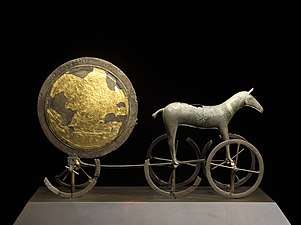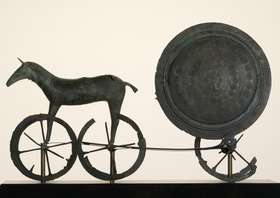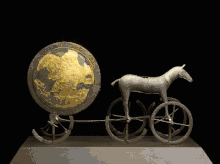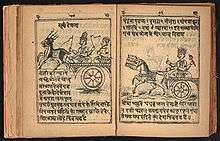Trundholm sun chariot
The Trundholm sun chariot (Danish: Solvognen), is a Nordic Bronze Age artifact discovered in Denmark. It is a representation of the sun chariot, a bronze statue of a horse and a large bronze disk, which are placed on a device with spoked wheels.


The sculpture was discovered with no accompanying objects in 1902 in a peat bog on the Trundholm moor in Odsherred in the northwestern part of Zealand, (approximately 55°55′N 11°37′E). It is now in the collection of the National Museum of Denmark in Copenhagen.
Description
The horse stands on a bronze rod supported by four wheels. The rod below the horse is connected to the disk, which is supported by two wheels. All of the wheels have four spokes. The artifact was cast in the lost wax method.
The whole object is approximately 54 cm × 35 cm × 29 cm (21 in × 14 in × 11 in) in size (width, height, depth).[1]
The disk has a diameter of approximately 25 cm (9.8 in). It is gilded on one side only, the right-hand side (when looking at the horse from behind). It consists of two bronze disks that are joined by an outer bronze ring, with a thin sheet of gold applied to one face. The disks were then decorated with punches and gravers with zones of motifs of concentric circles, with bands of zig-zag decoration between borders. The gold side has an extra outer zone which may represent rays, and also a zone with concentric circles linked by looping bands that "instead of flowing in one direction, progress like the steps of the dance, twice forward and once back". The main features of the horse are also highly decorated.[2]
The two sides of the disk have been interpreted as an indication of a belief that the Sun is drawn across the heavens from East to West during the day, presenting its bright side to the Earth and returns from West to East during the night, when the dark side is being presented to the Earth. A continuation around a globe would have the same result. It is thought that the chariot was pulled around during religious rituals to demonstrate the motion of the Sun in the heavens.[3]
Date
The sculpture is dated by the National Museum to about 1400 BC,[4] though other dates have been suggested. It was found before pollen-dating was developed, which would have enabled a more confident dating.
A model of a horse-drawn vehicle on spoked wheels in Northern Europe at such an early time is surprising; they would not be expected to appear until the end of the Late Bronze Age, which ranges from 1100 BC to 550 BC. This and aspects of the decoration may suggest a Danubian origin or influence in the object, although the Nationalmuseet is confident it is of Nordic origin.[5]
Possible function as a calendar

Klavs Randsborg, professor of archeology at the University of Copenhagen, has pointed out that the sum of an addition of the number of spirals in each circle of the disk, multiplied by the number of the circles in which they are found, counted from the middle (1x1 + 2x8 + 3x20 + 4x25), results in a total of 177, which comes very close to the number of days in six synodic months, only 44 min 2.8 s shorter each.
The synodic cycle is the time that elapses between two successive conjunctions of an object in the sky, such as a specific star with the Sun. It is the time that elapses before the object will reappear at the same point in the sky when observed from the Earth, so it is the apparent orbital period observed from Earth.
He asserts his belief that this demonstrates that the disk was designed by a person with some measure of astronomic knowledge and that the sculpture may have functioned as a calendar.
Sun chariot in Indo-European mythology
Norse mythology
The chariot has been interpreted as a possible Bronze Age predecessor to Skinfaxi,[6] the horse that pulled Dagr, the personification of day, across the sky.
Celtic Pantheon
The sky god Taranis is typically depicted with the attribute of a spoked wheel.
Rigveda

The Rigveda also reflects the mytheme of the Sun chariot. RV 10.85 mentions the sun god's bride as seated on a chariot pulled by two steeds. The relevant verses are the following (trans. Griffith):
10. Her spirit was the bridal car; the covering thereof was heaven: Bright were both Steeds that drew it when Surya approached her husband's home.
11. Thy Steeds were steady, kept in place by holy verse and Sama-hymn: All car were thy two chariot wheels: thy path was tremulous in the sky,
12. Clean, as thou wentest, were thy wheels, wind was the axle fastened there. Surya, proceeding to her Lord, mounted a spirit-fashioned car.[7]
See also
- Egtved Girl
- Golden hat
- Håga Kurgan
- Nebra skydisk
- Nordic Bronze Age
- Phaëton
- Sól (sun)
- Sun worship
- The King's Grave
- Urnfield culture
- Cult Wagon of Strettweg
Notes
- Nationalmuseet
- Sandars, 184-185
- Sandars, 184; see also Nationalmuseet video
- http://natmus.dk/historisk-viden/danmark/oldtid-indtil-aar-1050/bronzealderen-1700-fkr-500-fkr/solvognen/
- Nationalmuseet video; Sandars, 183-185 favours Danubian influence, and a date at the end of the 13th century.
- Lindow, John. (2001) Norse Mythology: A Guide to the Gods, Heroes, Rituals, and Beliefs, page 272. Oxford University Press ISBN 0-19-515382-0.
- Mandala 10/Hymn 85
References
- Sandars, Nancy K., Prehistoric Art in Europe, Penguin (Pelican, now Yale, History of Art), 1968 (nb 1st edn.)
External links
| Wikimedia Commons has media related to Trundholm Sun Chariot. |
- Reconstructing the Trundholm Sun Chariot, Anders Söderberg, Sweden, 2002. Söderberg demonstrates how part of the chariot might have been made using the lost-wax method.
- Götter und Helden in der Bronzezeit: Europa im Zeitalter des Odysseus, exhibition, Bonn. 1999. Catalogue introduction, wall panel information: (.doc format)